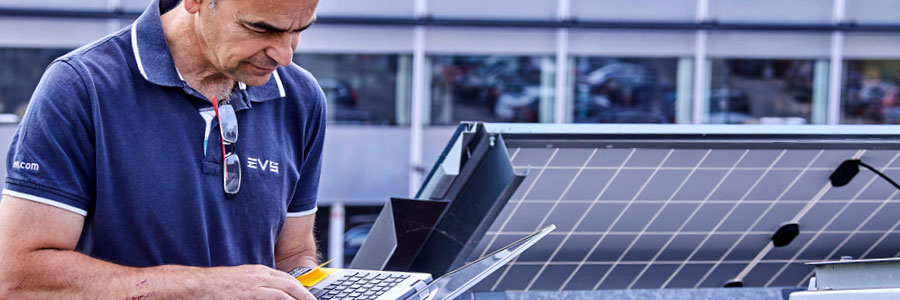Sign up to receive bi-monthly updates featuring the latest news from EVS, advancements in broadcast technology, and ongoing progress in our sustainability and ESG initiatives.
Intelligent power management might be what saves our industry
By Alex Redfern, CTO at EVS
- 28 July 2025

EVS and our commitment to ESG: Driving sustainability in our industry
ESG is integral to how EVS operates, it's not just a box to check. On the environmental side, we’ve taken meaningful steps such as installing solar panels to power our headquarters, designing our offices to maximize natural airflow and minimize heat loss, and even maintaining on-site beehives to support biodiversity.
Socially, we’re proud to be a certified Top Employer with high levels of team engagement. We also invest in our communities through various charity initiatives, sponsorships, and educational outreach programs.
And from a governance standpoint, we promote diversity starting at the board level and have implemented comprehensive cybersecurity policies to protect our teams and our customers.
ESG is intricately linked to our strategy.
When we talk about “sustainable growth,” we mean not just economic sustainability, but environmental sustainability too. To support this vision, we’ve formed a cross-departmental ESG Core Team dedicated to measuring and improving our ESG impact through company-wide policies.
In 2021, we conducted our first carbon footprint assessment, a milestone that revealed both our strengths and our most urgent opportunities for improvement. This is what accelerated our focus on intelligent power management.

Solar panels at EVS headquarters
Tackling the "always on" problem: Building an intelligent power management tool
Broadcast infrastructure has historically been built for reliability and uptime. But that same reliability-first mindset has contributed to inefficiencies, especially when systems are left running overnight, over the weekend, or even longer, without being used.
We confronted this issue early on in our ESG journey. We found that simply asking employees to turn off their systems wasn’t enough. We needed to automate start-up and shutdown processes to make it easier for teams to reduce their energy footprint, especially in development environments that aren’t always cloud-based.
Yes, the cloud helps, but not everything runs there. Our dev tools, hardware, and software products often operate on physical infrastructure, and many of our workflows require overnight builds and testing.
To address this, we began exploring ways to automate power management across environments, starting with virtual machines, then physical machines, and eventually, our custom hardware like XT servers.
Using standard protocols such as IPMI and OS-level controls, we created an internal web-based tool that lets engineering teams start and stop their machines with ease. We added scheduling, automation, and a simple UI to drive adoption.
As the platform matured, we integrated monitoring tools like Grafana and built a scheduling interface so systems could power down on Friday and reliably restart Monday. We also added support for remote switches to gracefully shut down and fully power off hardware.
So... Does it work?
In Q1 2025, we recorded a 4.4% reduction in weekend power consumption at our HQ, a direct result of improved shutdown habits. It might sound small, but it’s measurable. And measurability means we can set targets and track real progress.
Compared to Q1 2024, we’re using less energy and generating more ourselves, 8.1% of our consumption now comes from solar power. And this is just at our headquarters. As we scale these tools across global offices, the impact compounds.
From internal tool to industry opportunity
The turning point came when we analyzed our 2021 carbon footprint. The results were eye-opening: 63% of our energy consumption comes from the use of our products by customers—or essentially Scope 3 emissions. To reduce our footprint, we need to help customers reduce theirs.
Of course, more efficient hardware helps, and we’ve made strides there. Our Neuron View multiviewer for instance draws 10–20% of the power of an off-the-shelf equivalent. Our XT production servers have doubled channel counts (from 6 to 12+), then moved from 1080i to 1080p (doubling the bandwidth again). A 6-channel XT3 in 1080i drew around 300W, whereas a 12+ channel XT-VIA in 1080p draws around 415W. That’s a relatively modest ~30% power increase for over quadruple the bandwidth increase.
But there’s no magic bullet. Power efficiency in software-defined systems is an iterative process: better hardware, smarter code, gradual gains.
What is immediate and impactful? Reducing how long things stay powered on. It’s a practical area where both EVS and our customers can drive progress right now. That’s why, since 2024, we have begun transforming what we'd been building internally into a productized capability.

Power management tool at EVS
Cultural impact: Innovation through ESG
What’s especially inspiring is how this energy management platform started. It wasn’t a top-down initiative—it began as a side project by a group of passionate interns, many of whom are now full-time team members. It’s a great example of how younger generations are helping to blend the "E" and "S" of ESG into one mission.
The project has in fact sparked a real cultural shift. At our October 2024 hackathon, ESG was a central theme, with three teams focusing on energy-efficient ideas.
One team took it further. They realized our Broadcast Control & Orchestration product Cerebrum already integrates with hundreds of third-party systems. Their proposal: extend that integration to include power monitoring and control capabilities based on the same principles developed internally.
That concept is now in development, demonstrating how ESG can fuel innovation, not just in how we operate, but in the solutions we offer to the industry.
Conclusion: A broader view of sustainability
The broadcast industry talks a lot about sustainability, often equating it with energy efficiency. That’s important, but too narrow. With many organizations still relying on on-prem, legacy infrastructure,“just move to the cloud” isn’t always a realistic or immediate option.
At EVS, we believe the biggest immediate win comes from better power management across existing deployments. That’s the focus of our internal automation efforts; optimizing how and when systems are powered on and off, without disrupting workflows. And we’re confident it’s one of the most practical, scalable ways we can reduce not only our carbon footprint, but also that of our customers.

Alex Redfern is responsible for EVS's R&D department, overseeing the delivery of innovative solutions. He holds a BSc in Media Technology from Southampton Solent University and has been with EVS for over 15 years. Alex brings a wealth of practical experience from customer support at big events to designing large-scale systems for live productions and leading a global team of solution architects. Alex’s current focus is on aligning technology investments with EVS’s business goals.